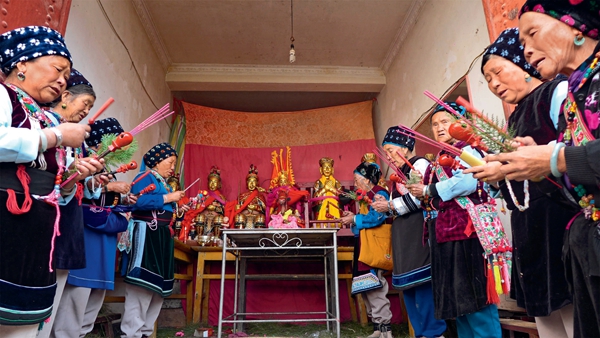Carnivals between Cangshan Mountain and Erhai Lake
China Today,January 09, 2018 Adjust font size:
Bai Valentine’s Day
The customs and rituals practiced during Raosanling are folk conventions. During each festival, thousands of Bai people from various villages around Erhai Lake gather before starting out on their pilgrimage to the three temples. Their foreheads adorned with sun-shaped patterns, their heads with colorful headbands to pray for a golden harvest, they also carry gourds as a symbol of fertility.
Each group generally consists of three sections. At the front are two village elders wearing distinctive outfits of white turbans and white shirt, colorful silk pants, and slippers decorated with red-pompons. Between them they carry a gourd hanging from a willow branch decorated with lengths of colored silk. One of them also holds a horsetail whisk, the other a red fan or a white towel. In the middle of the group is a man playing the flute, accompanied by octagonal drummers, who perform a part-talking part-singing narrative on life and happiness set to traditional melodies. This is a way of showing respect for local gods, Buddha, and Taoist deities. At the end of the procession is one person who makes music by blowing a leaf, along with a dozen singing and dancing women, all holding fans or straw hats. Led by the two elders, the group converges with those from other villages in this vibrant spring festival celebrated by more than 10,000 people.

Worshipping local deities is a custom more than 1,000 years old.
When this procession, alive with song and dance, arrives at a village, villagers “intentionally” block its way, and select their own best singer to dance and sing with them. When they’ve had their fill of fun they let the procession pass. In the evening, revelers light bonfires in the fields and woods to cook dinner. Elders drink tea and play the sanxian, a three-stringed plucked musical instrument, while young people have trysts in a nearby forest.
As in most ethnic festivals, young men and women’s thoughts turn to love and romance at the Raosanling. It is after all the perfect time to find a person to hold close to your heart. But the Raosanling is distinct in being an occasion when the Bai people, regardless of age or sex, dally freely with old flames and sweethearts without fear of censure from the local folk. This is a custom unique to the Bai people. lt gives former lovers the opportunity to reacquaint with one another without incurring anger or moral condemnation from their respective families. Some of the elders taking part in the festival may be heard singing the song: “Although I’m too old to sing well, I still want to sit silently by you.”
This Raosanling style Valentine’s Day gives the festival a touch of nostalgic passion.